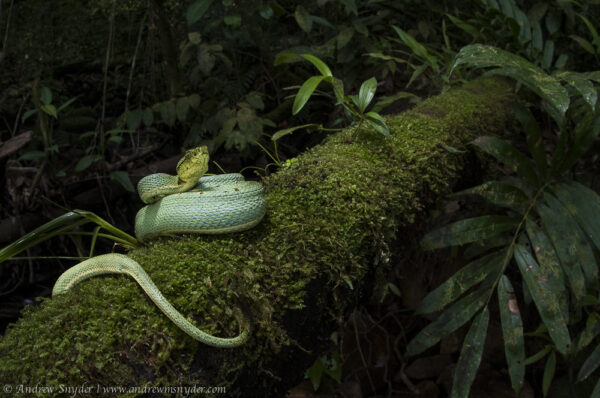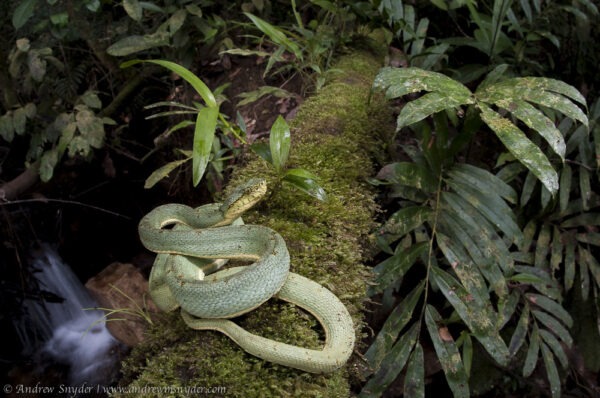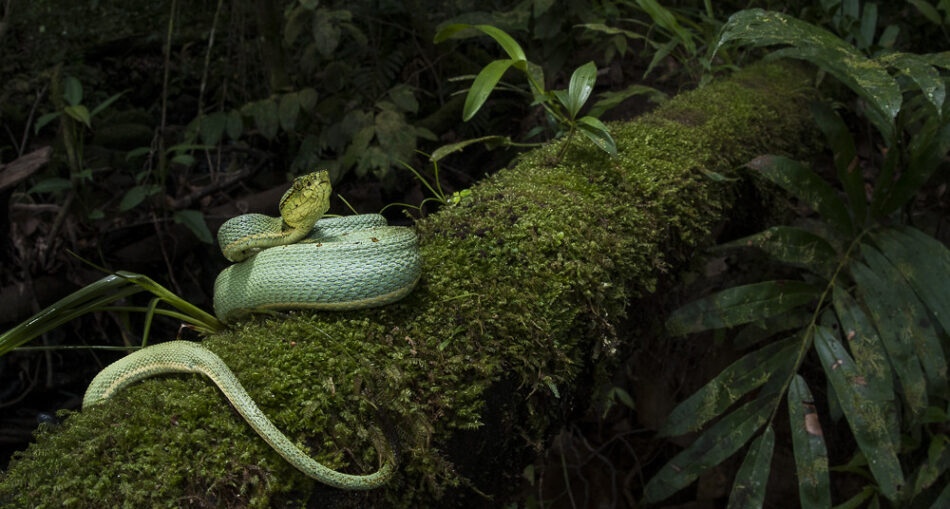Guyana, a country teeming with biodiversity, is home to an array of exotic wildlife, including some of the most fascinating reptiles in the world.

The bi-striped viper snake [Photo: Andrew Snyder]
Found primarily in the dense rainforests of Guyana, this elusive serpent may not be as well-known as other snakes, but it certainly deserves attention for its unique characteristics and vital role in maintaining ecological balance.
IDENTIFICATION AND PHYSICAL FEATURES
The bi-striped viper snake, as its name suggests, is easily identifiable by the two prominent light-coloured stripes that run along the length of its body, set against a darker backdrop.
The body of the snake typically ranges from light brown to olive green, offering excellent camouflage in its natural habitat. This slender, moderately-sized snake can grow up to 1.5 meters (5 feet) in length.
Its head is triangular, typical of vipers, with heat-sensing pits that allow it to detect warm-blooded prey, even in complete darkness.
This snake’s large, retractable fangs deliver a potent venom capable of instantly immobilising its prey.
Despite its venomous nature, the bi-striped viper is not typically aggressive toward humans unless provoked, making it an important yet often misunderstood species within Guyana’s reptilian world.
HABITAT IN GUYANA
The bi-striped viper snake is native to Guyana’s tropical rainforests and thrives in the humid, dense vegetation.
The country’s rich ecosystems, ranging from the Rupununi savannahs to the Amazon basin, provide a perfect environment for this snake.
The snake favours areas near water sources, such as rivers, streams, and swampy lowlands, where it hunts for its prey.
Guyana’s rainforests are part of the Amazon basin, known for their exceptional biodiversity.
The bi-striped viper plays an integral role in these ecosystems by controlling the populations of small mammals, birds, and amphibians which it preys upon.

The bi-striped viper snake [Photo: Andrew Snyder]
DIET AND HUNTING BEHAVIOUR
As a nocturnal hunter, the bi-striped viper is most active at night, when it relies on its heat-sensing pits to locate warm-blooded prey. Its diet primarily consists of small mammals, birds, and amphibians, although it has been known to consume insects and other reptiles as well.
When hunting, the snake remains motionless, blending into its surroundings until a potential meal comes within striking range.
Once close enough, the snake strikes with incredible speed, injecting its venom into the prey. The venom not only paralyses the animal but also begins digestion by breaking down tissues, making it easier for the snake to consume its meal.
Interestingly, the bi-striped viper is an ambush predator, often lying in wait for hours or even days in a single spot, waiting for the perfect opportunity to strike.
REPRODUCTION AND LIFESPAN
The bi-striped viper is ovoviviparous, meaning that females give birth to live young rather than laying eggs. During mating season, which typically occurs in the warmer months, males engage in combat rituals, competing for the right to mate with receptive females.
After mating, the female carries the developing embryos inside her body for several months before giving birth to live young, usually numbering between 5 and 20.
The young vipers are fully independent from birth, equipped with venom and fangs, allowing them to hunt and defend themselves immediately.
The lifespan of a bi-striped viper in the wild is estimated to be around 10-15 years. However, this can vary based on environmental conditions and threats from predators or human activity.
ROLE IN ECOSYSTEM AND IMPORTANCE TO BIODIVERSITY
In the grand tapestry of Guyana’s wildlife, the bi-striped viper plays an essential role in controlling the population of small animals, which helps prevent overgrasing and the depletion of resources in the rainforest.
By keeping these populations in check, the bi-striped viper indirectly contributes to the health of the forest, ensuring that vegetation can thrive and support a diverse range of species.
Additionally, snakes like the bi-striped viper are an important part of the food chain. They are preyed upon by larger animals, such as birds of prey, and their presence supports the complex web of life in the rainforests of Guyana.
References
- https://www.fieldherpforum.com/forum/viewtopic.php?t=19642
- https://www.naturepl.com/stock-photo/bi-striped-viper-(bothriopsis-bilineata)-chenapau-guyana/search/detail-0_01461498.html?srsltid=AfmBOoop_6obIB72FLN6gRk87D7_axcTfJ4nzjw2L83SEqmubn29_Yz3
- https://www.fieldherpforum.com/forum/viewtopic.php?t=19642
Discover more from Things Guyana
Subscribe to get the latest posts sent to your email.







